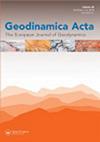The ups and downs of Diplocraterion in the Glen Rose Formation (Lower Cretaceous), Dinosaur Valley State Park, Texas (USA)
IF 1.5
Q1 Earth and Planetary Sciences
引用次数: 8
Abstract
Diplocraterion, a U-shaped burrow attributed to infaunal invertebrates, is normally a shallow-marine trace fossil and not part of a continental vertebrate ichnoassemblage. Hence, the Glen Rose Formation (Aptian–Albian) of Texas (USA) presents an opportunity to study Diplocraterion associated with a world-class dinosaur tracksite. Most Diplocraterion are in a bioclastic wackestone–packstone bed just above the Taylor Tracklayer, a significant dinosaur track horizon. Diplocraterion are consistently sized, but with variable depths; most have protrusive spreiten and northeast–southwest trends. Smaller Arenicolites co-occur with Diplocraterion, and other trace fossils include Rhizocorallium and a large theropod trackway. Based on our analysis, a sea-level rise buried the Taylor Tracklayer, with a shallow-marine carbonate mud colonised by Diplocraterion and Arenicolites tracemakers. Protrusive Diplocraterion, eroded burrow tops, Rhizocorallium, and other criteria point towards firming and net erosion of the bed caused by a stillstand. The depositional environment of the Diplocraterion bed was possibly a subtidal lagoon that covered shoreward sediments impacted by large theropods. Burrow orientations suggest bidirectional currents consistent with trends of theropod trackways, implying each were controlled by a shoreline. The results of our study demonstrate how marine invertebrate and continental vertebrate trace fossils can be used together to define fine-scale changes in former carbonate shorelines.美国德克萨斯州恐龙谷州立公园,格伦玫瑰组(下白垩纪)外交的起伏
diplocration,一种被认为是水生无脊椎动物的u形洞穴,通常是浅海的痕迹化石,而不是大陆脊椎动物技术组合的一部分。因此,美国德克萨斯州的格伦罗斯组(Aptian-Albian)提供了一个研究与世界级恐龙足迹遗址相关的外交关系的机会。大多数diplocration位于生物碎屑岩-砾岩层中,就在泰勒足迹层之上,这是一个重要的恐龙足迹层。外交是一致的大小,但具有不同的深度;大多数有突出的精灵和东北-西南的趋势。较小的砂粒石与双角纪共存,其他的痕迹化石包括Rhizocorallium和大型兽脚亚目恐龙的足迹。根据我们的分析,海平面上升掩埋了泰勒追踪层,这是一种浅海碳酸盐泥浆,由普洛克拉纪和砂粒石追踪器占据。突出的凹陷,侵蚀的洞穴顶部,根茎藻和其他标准指向固结和净侵蚀造成的床。diplocartion的沉积环境可能是一个潮下泻湖,覆盖了受大型兽脚亚目动物影响的岸边沉积物。洞穴的方向显示出与兽脚亚目恐龙足迹趋势一致的双向洋流,这意味着每条洋流都受到海岸线的控制。我们的研究结果表明,海洋无脊椎动物和大陆脊椎动物的痕迹化石可以一起用来定义前碳酸盐海岸线的精细尺度变化。
本文章由计算机程序翻译,如有差异,请以英文原文为准。
求助全文
约1分钟内获得全文
求助全文
来源期刊

Geodinamica Acta
地学-地球科学综合
CiteScore
4.50
自引率
0.00%
发文量
0
审稿时长
25 weeks
期刊介绍:
Geodinamica Acta provides an international and interdisciplinary forum for the publication of results of recent research dealing with both internal and external geodynamics. Its aims to promote discussion between the various disciplines that work on the dynamics of the lithosphere and hydrosphere. There are no constraints over themes, provided the main thrust of the paper relates to Earth''s internal and external geodynamics. The Journal encourages the submission of papers in all fields of earth sciences, such as biostratigraphy, geochemistry, geochronology and thermochronology, geohazards and their societal impacts, geomorphology, geophysics, glaciology, igneous and metamorphic petrology, magmatism, marine geology, metamorphism, mineral-deposits and energy resources, mineralogy, orogeny, palaeoclimatology, palaeoecology, paleoceanograpgy, palaeontology, petroleum geology, sedimentology, seismology and earthquakes, stratigraphy, structural geology, surface processes, tectonics (neoteoctonic, plate tectonics, seismo-tectonics, Active tectonics) and volcanism.
Geodinamica Acta publishes high quality, peer-reviewed original and timely scientific papers, comprehensive review articles on hot topics of current interest, rapid communications relating to a significant advance in the earth sciences with broad interest, and discussions of papers that have already appeared in recent issues of the journal. Book reviews are also included. Submitted papers must have international appeal and regional implications; they should present work that would be of interest to many different specialists. Geographic coverage is global and work on any part of the world is considered. The Journal also publishes thematic sets of papers on topical aspects of earth sciences or special issues of selected papers from conferences.
 求助内容:
求助内容: 应助结果提醒方式:
应助结果提醒方式:


